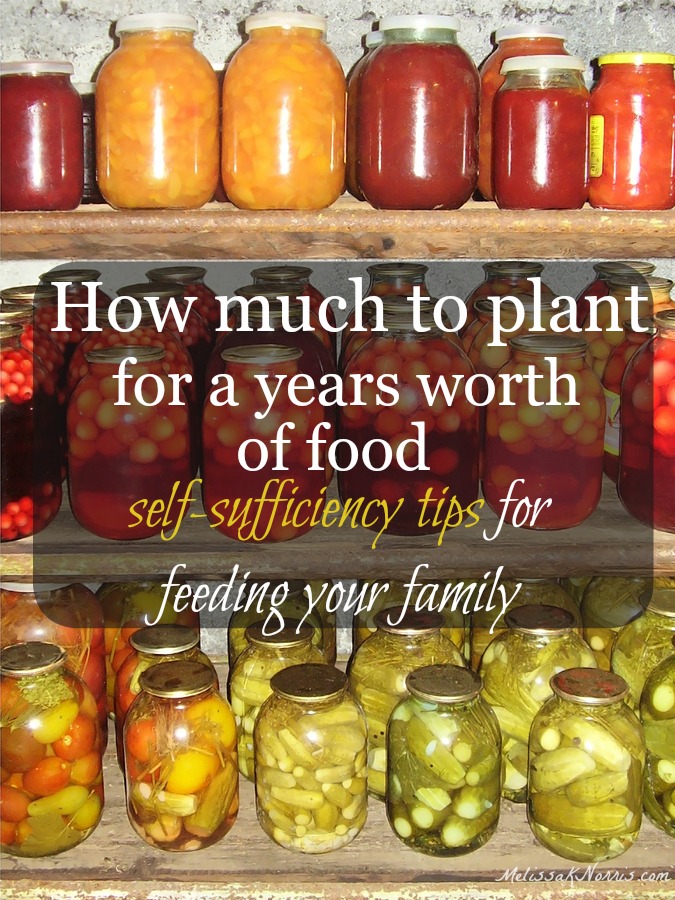

Most of us aren’t relying completely on what we plant and preserve ourselves, we’re still supplementing with the grocery store. But what if you did have to survive on what you’d planted and put up. How much money would it free up for you and your family?
Listen to this post (just push play below) and all our episodes of the
Pioneering Today Podcast while you’re on the go, scrubbing the house, cooking up dinner (can I get an invite?), or mucking out stalls! I post new episodes Friday mornings. You can subscribe via RSS and receive every episode for free.
Or subscribe via Itunes
What does growing a year’s worth of food look like?
I have to be honest with you, it’s going to vary a bit for every person and family.
Back in the pioneer days as well as the Great Depression, most families grew some of their own food, and many of them relied solely or almost solely on what they’d grown and preserved to feed themselves through the winter.
How much do you need to grow per person for a year?
There are three vegetable crops that we currently grow enough of that I don’t purchase from the store, as in ever.
Keep in mind this is for a family of four, and my son is not a teenager yet.
Beans. Ya probably guessed this is one of my favorites. Green beans go well all by themselves as your vegetable for a meal, or they’ll stretch a casserole or stew. One of our favorite foods is a pot of green beans simmered with a bit of fat back (aka bacon) thrown in.
Our strain of green bean is a pole bean and when allowed to mature on the vine, also doubles as a dried or shell bean. A lot of times these are also referred to as shelly beans.
Dried beans are awesome possum (confession, I’ve never ate possum, just in case there was any confusion there, but when I get excited about something I tend to rhyme) because they’re packed with protein and calories. This is one of the few times where we’ll get excited about a food having a lot of calories.
When you’re truly living off of what you can grow, especially if it’s not livestock (this allows you to render down a fat source) it can be hard to get a substantial amount of calories from just vegetables and fruit. A dried bean gives you both. (Here’s 5 Tips to Raising Livestock)
In my experience a pole bean gives you a much larger harvest for the amount of space than a bush bean. With our pole beans I plant approximately a total of 30 plants (3 bean plants on each 6 foot pole with 3 poles to a teepee, so 9 plants for each teepee) and from that I can about 50 to 60 jars of green beans, eat them fresh through the season, and save for both seed and as a dry bean over 200 beans.
The average recommendation of bean plants per person for a year’s worth of food is 10 to 20 plants per person.
This is going to depend on your growing season, the amount of harvest from your bean, and of course, how much your family actually consumes of that food in a year.
Garlic is such an easy crop to grow, especially when you do a fall planting. Most of the winter your garden is lying fallow, the perfect time to put the ground to use with garlic. Harvest in the summer and you can still use that space for late summer and early fall crops.
We tend to always double the garlic in a recipe at our house, just saying. For us about 50 bulbs of garlic takes us all the way through the year.
The average recommended amount is 15 bulbs per person, but with garlic, I say err on the side of having too many (because that’s really not ever the case) Plus, garlic can be used medicinally and also fed to livestock. We give a few cloves of garlic every week to our piglets and many people also supplement with garlic for their chickens.
Tomatoes. Tomatoes are probably the most versatile of all the vegetables (I know, technically it’s a fruit). From salsa, stewed tomatoes, tomato sauce, ketchup, pizza sauce, marinara, tomato soup, see, tomatoes go with just about every meal and in between.

I grow 18 tomato plants for our family of four and am able to can close to 40 jars of salsa, 10 quarts of stewed tomatoes, and 25 jars of tomato sauce.
For those of us planning on growing enough tomatoes for a year, that means we’ll be preserving them, and when you’re preserving, paste tomatoes are the name of the game. While I love cherry tomatoes and sliced tomato sandwiches, paste tomatoes are going to carry you much farther with canning and making your sauces.
If you’re growing your food with the goal of having enough to eat for the whole year, you’re going to have to preserve it. We’ve got our FREE Ultimate Home Food Preservation Guide to help you do that along with our Chart-How Much to Plant for a Year’s Worth of Food over 20+ vegetables.
Summer squash is quite prolific. In fact we have a joke around here that when zucchini is on, don’t leave your car windows down or your doors unlocked, or you might find a surprise of zucchini.
General recommendation is 1 plant per person for summer squash.
Winter squash is awesome because you can use root cellar techniques for your food storage. For more info one using root cellar techniques without a root cellar check out 10 Tips for Storing Vegetables w/out a Root Cellar Long Term
I have successfully stored spaghetti squash in our kitchen with root cellar techniques from the end of August until mid-March.
General recommendation for winter squash is 2 to 3 plants per person.
Best plants for protein and calorie content
One thing you want to consider when trying to grow your own food is having a food source that is high in protein and calories, which can be hard to establish with just vegetables.
Dried peas and beans fit this bill. Make sure you have at least one or the other as one of your staple crops when growing enough food for a whole year for your family.
For more charts and information on becoming self-sufficient and raising your own food, including worksheets, go to The Made-From-Scratch Life.
Original article and pictures take http://melissaknorris.com/how-much-to-plant-for-a-years-worth-of-food/ site
Комментариев нет:
Отправить комментарий